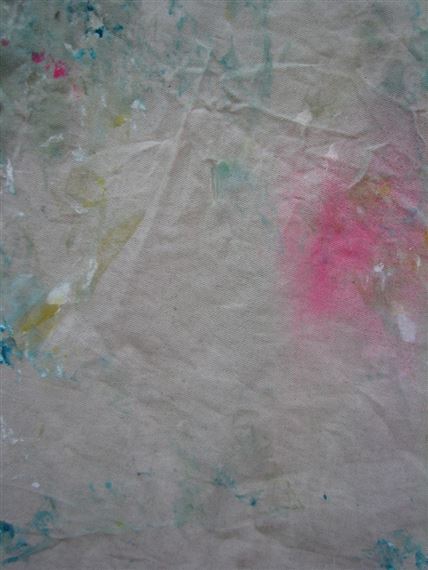Anthony N鈥橤oya & Shao-Jie Lin: Under a Flag
The two artists employ vastly different languages; Lin's is a carefully constructed statement often social and political, the message covered under the subtle and simple, but intriguing visual. His objects are created by deconstructing original materials, image or ideas, and composed anew; thoughts and ideas are weaved in at every step of the process and become an integral part of the physicality of the works. The reconfigured materials and internalised concepts render the gracious presence of Lin鈥檚 objects into a quiet yet potent statement.
Dynamic, fluid and intuitive, the oeuvre of Ngoya is personal, reflecting his own life and identity. His practice is based on painting, but he often works directly with untreated canvas sheets or repurposed fabric. His liberal use of found objects such as discarded construction materials asserts the contemporary life and incorporates marginal or non-mainstream existence through decontextualisation and recontextualisation. Feel of roughness that is omnipresent in Ngoya's works, either physically or metaphysically, only reveals the acute sense of sophisticated equilibrium or very slight lack of it, as if to arouse curiosity and uneasiness.
Formally the practices of the the two artists may seem to be the farthest away from each other, but then, the drive for creation and their conceptual backgrounds have some common elements, one of which is a deep-rooted question of identity. Lin's primary concerns evolve around the ideas of immigration, national borders, the concept of nation state and sentiments deriving from it, such as national pride. Ngoya's practice is driven by his desire to trace back time and revive memory or reconstruct the past, present and future both real and imagined. As a member of the society where his parents came to live, his idea of past, present and future and memory are naturally shaped at least partly by the conscious or unconscious conceptualisation of where they came from, where they came to, and the conflict as well as the wealth of living and owning more than one culture.

Recommended for you
The two artists employ vastly different languages; Lin's is a carefully constructed statement often social and political, the message covered under the subtle and simple, but intriguing visual. His objects are created by deconstructing original materials, image or ideas, and composed anew; thoughts and ideas are weaved in at every step of the process and become an integral part of the physicality of the works. The reconfigured materials and internalised concepts render the gracious presence of Lin鈥檚 objects into a quiet yet potent statement.
Dynamic, fluid and intuitive, the oeuvre of Ngoya is personal, reflecting his own life and identity. His practice is based on painting, but he often works directly with untreated canvas sheets or repurposed fabric. His liberal use of found objects such as discarded construction materials asserts the contemporary life and incorporates marginal or non-mainstream existence through decontextualisation and recontextualisation. Feel of roughness that is omnipresent in Ngoya's works, either physically or metaphysically, only reveals the acute sense of sophisticated equilibrium or very slight lack of it, as if to arouse curiosity and uneasiness.
Formally the practices of the the two artists may seem to be the farthest away from each other, but then, the drive for creation and their conceptual backgrounds have some common elements, one of which is a deep-rooted question of identity. Lin's primary concerns evolve around the ideas of immigration, national borders, the concept of nation state and sentiments deriving from it, such as national pride. Ngoya's practice is driven by his desire to trace back time and revive memory or reconstruct the past, present and future both real and imagined. As a member of the society where his parents came to live, his idea of past, present and future and memory are naturally shaped at least partly by the conscious or unconscious conceptualisation of where they came from, where they came to, and the conflict as well as the wealth of living and owning more than one culture.













